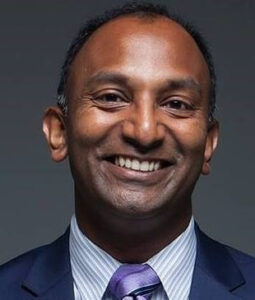Thiru Vignarajah: Stop Blaming Others for Baltimore City’s Failures
You will never hear “the buck stops here” from Baltimore City politicians. This time, city leaders have been quick to point fingers at state administrators for the botched vaccine rollout. This is nothing new. From broken schools to budget shortfalls, claiming credit for trivial progress while reassigning responsibility for major failures is a dependable political tradition in Baltimore.
In the context of vaccine distribution, however, data showing how much worse the city is doing compared to other Maryland counties makes it hard for Baltimore politicians like Mayor Brandon Scott to pin blame solely on the governor. In February, for example, Baltimore City (the fourth most populous jurisdiction) received the third highest allocation of vaccines statewide yet manages to get the smallest fraction of that allocation into people’s arms.
Even worse, only half of those doses went to city residents. That is partly because health care workers were prioritized in the very first phase of the rollout, and Baltimore boasts 11 hospitals anchoring its neighborhoods. But it is also because of a busted transit grid, lack of communication with the community, inadequate health care infrastructure, digital access deficits among the elderly generally and Black residents specifically, and the same incompetence and inefficiencies that plague every other operation in Baltimore, from fighting crime to fixing potholes.
Those are local challenges, and certain localities have simply been better at addressing them. Baltimore County, for example, has devoted CARES funds to pay for Uber rides for residents without transportation. Indeed, a side-by-side comparison of Baltimore City and Prince George’s County, Maryland’s two majority Black jurisdictions, is especially revealing.
Black residents make up 64% of Prince George’s County and 62% of Baltimore City. Leaders in both places are frustrated that many of their doses are going to residents of neighboring counties. For example, a third of the vaccines administered at the Six Flags mass vaccination site in Prince George’s County have gone to Montgomery County residents. But, in the end, as of March 7, a solid 52,381 of 91,596 first doses in Prince George’s County went to Black residents (57%), while only 27,474 of 78,934 first doses in Baltimore City have gone to Black residents (35%).
Bottom line, Prince George’s County has directed a far more appropriate share of its vaccines to its Black residents, and its leaders have not had to pick a fight with the governor to accomplish this. On the contrary, Democrats like Prince George’s County Executive Angela Alsobrooks and Baltimore County Executive Johnny Olszewski have worked alongside Gov. Larry Hogan, while city leaders have spent the last month basically calling him a racist.
The state’s vaccine distribution efforts are hardly beyond reproach.
At the federal level, President Biden has delivered refreshing competence and common sense overnight, but frankly no state anywhere — led by Republicans or Democrats — has gotten its part right.

Thiru Vignarajah
So, there is nothing wrong with showing empathy and frustration, criticizing Maryland leadership in a constructive fashion, or advocating for specific policies (like setting aside doses for city residents at certain vaccine sites). But calling press conferences just to lob insults at an outgoing governor does not project moxie and toughness — it betrays a disoriented captain still trying to find his sea legs. It also instantly imperils the relationship between a new mayor and a critical partner for the next two years.
But saying the mayor should not pick needless fights with the governor is not a vaccine strategy either, so here are three concrete steps Baltimore City could take to raise the share of Black residents in particular and city residents overall who are getting the vaccine:
First, while many eligible individuals during Phase 1 may need to feverishly refresh websites and obsessively call hotlines to get an appointment, the city should affirmatively reach out to elderly citizens and offer them an appointment and assist with logistics. Relying on jury and voter rolls, MVA records and even databases that political candidates use to contact prospective voters, Baltimore City should pick up the phone and call everyone over 85 to schedule a slot, arrange transportation and ensure they are vaccinated in the next two weeks. Then they should expand the operation to senior citizens over 80, then over 75, and so on.
Many of these seniors are missing out not because of reluctance or fear, but because of the Byzantine gauntlet we expect our elderly to run.
Second, city health officials should immediately engage with Baltimore’s 20 largest churches and coordinate vaccine distribution at those locations. Baltimore residents trust their faith leaders, they are accustomed to getting themselves to those places every Sunday morning, and these large religious institutions are neatly distributed across the entire city.
Finally, Baltimore should create a single hotline and web portal where a person can provide the full range of necessary information just one time. During the call or through the online form, residents could also consent to have trained city employees take that information and complete dozens of request forms on the individual’s behalf, instead of expecting a 90-year-old grandmother to log in each morning, jump from one website to another, and input the same personal information (with slight variations) over and over again.
Baltimore should assume this responsibility not because the rest of the process is perfect — it is far from it. Rather, city leaders should act because our residents are competing with people across the state for vaccine appointments, and right now we are losing.
Short of taking steps like these, Mayor Scott’s current rhetoric to heap blame onto the governor rings hollow because, candidly, everyone knows the city has bungled basic municipal functions, from street sweeping to trash collection to water bills, for decades.
Down the road, there will be ample opportunity to look back, conduct a postmortem and decide who is to blame. Right now, however, every ounce of municipal energy, every press conference and policy announcement, every innovation and insight should be used to help city residents steer the terrible maze we have erected.
Everything else is political grandstanding, and it is actively distracting from what should be the primary objective: to get vaccines into vulnerable residents’ arms.
— THIRU VIGNARAJAH
The writer previously served as deputy attorney general of Maryland and was a candidate for mayor in the 2020 Democratic primary in Baltimore.





 Creative Commons Attribution
Creative Commons Attribution